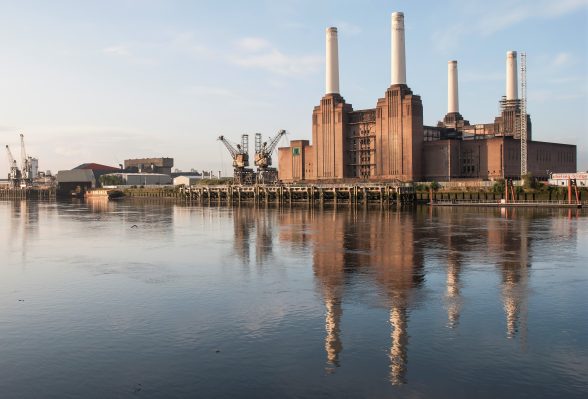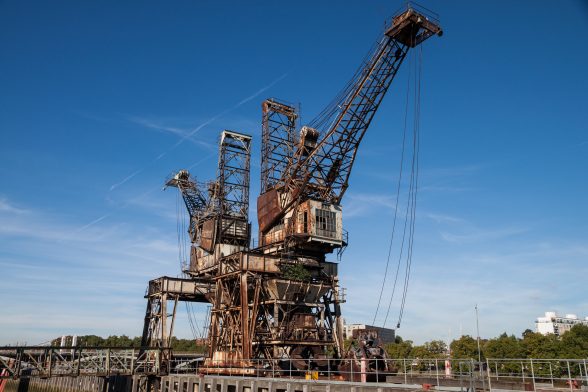This website uses cookies
This website uses cookies to enable it to function properly and to analyse how the website is used. Please click 'Close' to accept and continue using the website.



Image: Adrian Sun
Battersea Power Station – Sir Giles Gilbert Scott’s Grade II* listed brick cathedral (built between 1929-35 and 1937-41) and one of C20’s longest running cases – finally opened to the public in October 2022, thirty nine years after it was decommissioned and following a £9 billion redevelopment of the site (equivalent to the total cost of the 2012 London Olympics). Yet one key feature was notably absent from the restored power station – a pair of listed dock cranes that stood on the river jetty and once unloaded coal from collier boats.
Fabricated by Stothert & Pitt of Bath, the two cranes were believed to have been installed in the 1950s and were in use up until closure 1983. At peak times they would have unload up to 240 tonnes of coal per-hour into hoppers and conveyor belts that fed the power station. The Historic England list description for the Battersea site describes them as ‘parts of the original complex and now rare riverside features’.
The cranes were temporarily dismantled and removed from the jetty by the developers of Battersea Power Station in 2014, enabling the transportation of spoil from the nearby Northern Line Extension tunnelling works by river rather than road. The cranes were taken by barge to the Port of Tilbury for safe storage and specialist restoration; a return to the new six acre Riverside Park was anticipated in 2017 but never materialised.

Image: Jimmi Thøgersen
The Port of London authority has confirmed to C20 that the crane components are still in storage at Tilbury Docks, but that to their knowledge no restoration work had yet been undertaken. A spokesperson for Battersea Power Station Ltd issued the following statement on their plans for the restoration and return of the listed cranes:
‘To date, we have been focused on successfully opening the restored Power Station which welcomed the public for the first time in October 2022 and since then, we have introduced new heritage items throughout Power Station Park, such as original turbine equipment and segments from the original chimneys. The cranes remain in storage at the port of Tilbury in Essex, and we will be bringing forward a plan for these in the future.’
As a key listed structure of the wider Battersea site and a rare original industrial feature, C20 is calling on the developers to expedite their plans for the restoration and return of the cranes.

Image: Historic England
Listed and lost
It comes as Britain’s industrial heritage is once again in the spotlight. A set of four 1950’s electric cargo cranes at Prince’s Wharf on Bristol’s Floating Harbour were Grade II listed in November 2022. The four cranes are now in the ownership of Bristol City Council and form part of Bristol Museums’ collection
The Bristol cranes are the second largest group of historic cranes in the country made by Stothert and Pitt of Bath and believed to be the only ones still be in working order. Known as the ‘crane-makers to the world’ and leaders in the industry in the 19th and 20th centuries, they were same manufacturer as the examples formerly at Battersea Power Station. The largest group of 14 Stothert and Pitt cranes is located at London’s Royal Victoria Dock; at one point in time, they were installed at almost every port in the world.

Image: flowerpower59
However, while twentieth century industrial heritage is being celebrated and preserved in some corners of the country, it’s a very different story elsewhere. In Redcar, the steel blastfurnace that had dominated the skyline since 1979 was demolished by controlled explosion in November 2022. Taller than St Paul’s Cathedral, it was the second biggest blastfurnace in Europe when new and produced 10,000 tonnes of iron a day for the steelworks.
An ultra-modern new facility, it was meant to represent the start of a new era for British steelmaking. The industrial works of Teeside even reputedly acted as the inspiration behind futuristic dystopian cityscape in Ridley Scott’s sci-fi classic Blade Runner (the Director grew up in the region). Yet soon the steelmaking industry in the region slipped into a gradual decline and the Redcar works closed for the last time in 2015, with the loss of 2000 jobs. The site of the former steelworks is now earmarked as an investment zone as part of the Governments ‘Levelling Up’ initiative. In echoes of the controversy surrounding the listing and subsequent demolition Dorman Long tower, also in Redcar, the blastfurnace could have been retained as a proud landmark of industrial heritage among the new 21st century industries it is hoped will emerging on the Tees. Instead an invaluable link between past and future has been lost.

Become a C20 member today and help save our modern design heritage.